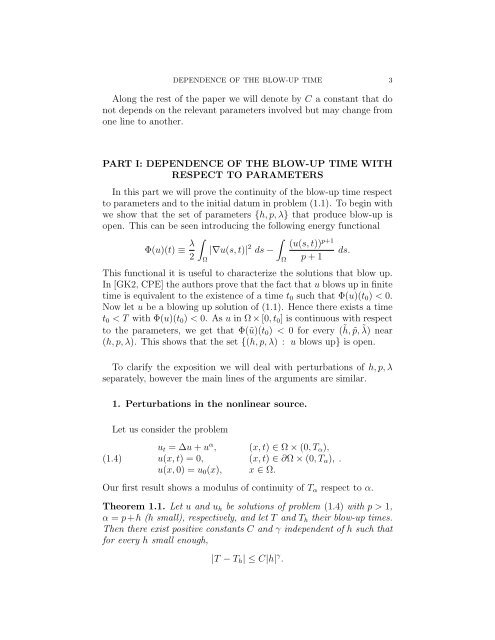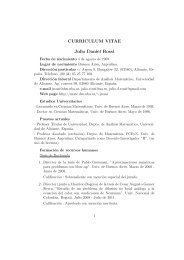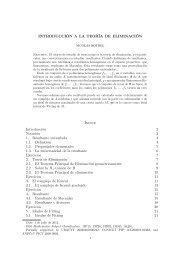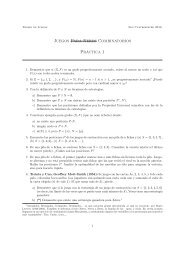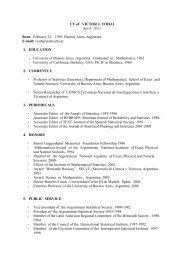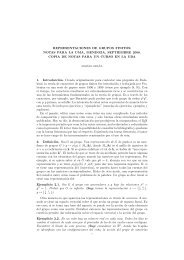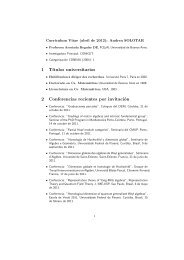Dependence of the blow-up time with respect - Universidad de ...
Dependence of the blow-up time with respect - Universidad de ...
Dependence of the blow-up time with respect - Universidad de ...
Create successful ePaper yourself
Turn your PDF publications into a flip-book with our unique Google optimized e-Paper software.
DEPENDENCE OF THE BLOW-UP TIME 3<br />
Along <strong>the</strong> rest <strong>of</strong> <strong>the</strong> paper we will <strong>de</strong>note by C a constant that do<br />
not <strong>de</strong>pends on <strong>the</strong> relevant parameters involved but may change from<br />
one line to ano<strong>the</strong>r.<br />
PART I: DEPENDENCE OF THE BLOW-UP TIME WITH<br />
RESPECT TO PARAMETERS<br />
In this part we will prove <strong>the</strong> continuity <strong>of</strong> <strong>the</strong> <strong>blow</strong>-<strong>up</strong> <strong>time</strong> <strong>respect</strong><br />
to parameters and to <strong>the</strong> initial datum in problem (1.1). To begin <strong>with</strong><br />
we show that <strong>the</strong> set <strong>of</strong> parameters {h, p, λ} that produce <strong>blow</strong>-<strong>up</strong> is<br />
open. This can be seen introducing <strong>the</strong> following energy functional<br />
Φ(u)(t) ≡ λ<br />
2<br />
<br />
Ω<br />
|∇u(s, t)| 2 <br />
ds −<br />
Ω<br />
(u(s, t)) p+1<br />
p + 1<br />
This functional it is useful to characterize <strong>the</strong> solutions that <strong>blow</strong> <strong>up</strong>.<br />
In [GK2, CPE] <strong>the</strong> authors prove that <strong>the</strong> fact that u <strong>blow</strong>s <strong>up</strong> in finite<br />
<strong>time</strong> is equivalent to <strong>the</strong> existence <strong>of</strong> a <strong>time</strong> t0 such that Φ(u)(t0) < 0.<br />
Now let u be a <strong>blow</strong>ing <strong>up</strong> solution <strong>of</strong> (1.1). Hence <strong>the</strong>re exists a <strong>time</strong><br />
t0 < T <strong>with</strong> Φ(u)(t0) < 0. As u in Ω × [0, t0] is continuous <strong>with</strong> <strong>respect</strong><br />
to <strong>the</strong> parameters, we get that Φ(ũ)(t0) < 0 for every ( ˜ h, ˜p, ˜ λ) near<br />
(h, p, λ). This shows that <strong>the</strong> set {(h, p, λ) : u <strong>blow</strong>s <strong>up</strong>} is open.<br />
To clarify <strong>the</strong> exposition we will <strong>de</strong>al <strong>with</strong> perturbations <strong>of</strong> h, p, λ<br />
separately, however <strong>the</strong> main lines <strong>of</strong> <strong>the</strong> arguments are similar.<br />
1. Perturbations in <strong>the</strong> nonlinear source.<br />
Let us consi<strong>de</strong>r <strong>the</strong> problem<br />
(1.4)<br />
ut = ∆u + u α , (x, t) ∈ Ω × (0, Tα),<br />
u(x, t) = 0, (x, t) ∈ ∂Ω × (0, Tα),<br />
u(x, 0) = u0(x), x ∈ Ω.<br />
Our first result shows a modulus <strong>of</strong> continuity <strong>of</strong> Tα <strong>respect</strong> to α.<br />
Theorem 1.1. Let u and uh be solutions <strong>of</strong> problem (1.4) <strong>with</strong> p > 1,<br />
α = p+h (h small), <strong>respect</strong>ively, and let T and Th <strong>the</strong>ir <strong>blow</strong>-<strong>up</strong> <strong>time</strong>s.<br />
Then <strong>the</strong>re exist positive constants C and γ in<strong>de</strong>pen<strong>de</strong>nt <strong>of</strong> h such that<br />
for every h small enough,<br />
|T − Th| ≤ C|h| γ .<br />
ds.<br />
.


